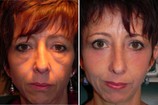As we age, we discover that one of the most noticeable changes to our appearance involves the eye area. Perhaps the most common complaint I receive as a specialist in cosmetic eyelid rejuvenation is that my patients have heard from others that they look sick or tired, even when they are feeling well and rested.
The origin of such unwanted comments is typically the nonverbal messages the lower eyelid region sends as we age. This area can be affected by many different factors which each contribute to the appearance of dark circles under the eyes—the first is the convexity or concavity of the lower eyelid fat. If the lower eyelid fat protrudes into the lower lid region, it often catches overhead shadows.
Take a look at the shadows demonstrated by the blue arrows in the photo of this patient whom I helped with my lower eyelid rejuvenation surgery.
Because most light is above us in our world (consider sunlight outside and room lights inside), this light is likely to cast a shadow over the protruding fat that becomes visible on the skin under the lower eyelid fat. The result of the shadowing is unattractive, dark circles, sending a message of fatigue or illness.
A converse problem relating to lower eyelid fat is rare but can occur occasionally and involves the lack of fat in the lower eyelid region, causing a sunkenin appearance that similarly catches and displays shadows in the lower eyelid skin. This is the second cause of dark circles under the eyes and make the eyes appear to have dark circles.
The third factor contributing to the appearance of dark circles under the eyes is dark pigment, which can deposit in the skin in the lower eyelid region. This is usually the result of sun exposure over a lifetime.
Notice the before surgery photo of this patient who had multiple dark age spots and pigment in the skin of the lower eyelid, demonstrated by the blue arrows. These spots, along with the upper and lower eyelid appearance, were helped with my upper and lower eyelid rejuvenation techniques.
A fourth factor patients experience leading to dark circles under the eyes is the underlying vessels transmitting through the thin skin in the lower eyelid region. This can be seen in the photo of this patient who had two causes of dark circles under their eyes. They had the fullness catching shadows but, as this photo demonstrates, they also had thin skin showing the pink vessels in this region of the lower eyelid skin closer to the nose.
Finally, the fifth factor, which can play a role in the appearance of dark circles under the eyes, is the presence of lower eyelid and cheek swelling, known as lower eyelid, cheek festoons and malar mounds. This can be seen by the blue arrows in the photo of this patient pointing to the festoons before I helped her with my lower eyelid rejuvenation procedures.
These are the five most common causes of dark circles under the eyes:
- Fullness below the eyes catching shadows.
- Hollowing under the eyes catching shadows.
- Brown pigment or age spots in the skin below the eyes.
- Thin skin and redness showing through the skin in the region below the eyes.
- Festoons and malar mounds catching shadows in the lower eyelid and cheek regions.,/li>
While these five common causes of dark eye circles can result in less than optimal nonverbal messages, there are options available to treat them, rejuvenating the appearance and restore effective non verbal communication.
Helping my patients with these issues is a true joy. I experience great satisfaction when patients report to me after I help them that others in the world better relate to them because these various causes of dark circles have been improved.
For more information on cosmetic eyelid rejuvenation, festoons, dark circles under the eyes, or services available for cosmetic surgery, Contact Our Office.



